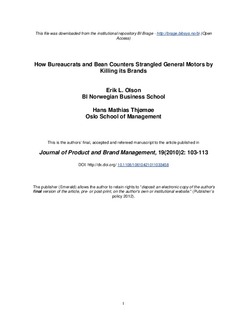| dc.description.abstract | Purpose: To use branding literature to understand the rise and fall of GM’s brands.
Design/Methodology/Approach: Case analysis using secondary sources covering GM’s brands and products, managerial leadership, and market and financial performance throughout its 100-year history.
Findings: During much of its first 50 years, GM was led by engineers who pioneered professional brand management, and through intelligent allocation of resources created one of the world’s strongest portfolio of brands. Government anti-trust hearings shifted GM to a cost-cutting orientation during its 2nd 50 years that had a negative impact on the GM brands and brought the current financial problems.
Research Limitation: This is a case study of only one firm, but parallels are drawn to other firms that have had similar brand issues.
Practical Implications: Firms with multiple brands need top management leadership to ensure each brand has a unique mission with minimal overlap and adequate resources for product development, innovation, and communications to achieve its mission. If the mission or resources disappear, non-core brands need to be terminated. Governments that wish to support well managed firms with strong brands need to be careful in using anti-trust actions, and should not force firms to make products that are not desired by customers.
Value: This paper takes a novel approach to evaluating the current state of General Motors by examining the factors that led to chronic mismanagement of its brands, which in turn has reduced brand equity, market share, and profits that have magnified GM’s problems with labor and legacy costs, productivity, and product mix. | no_NO |
